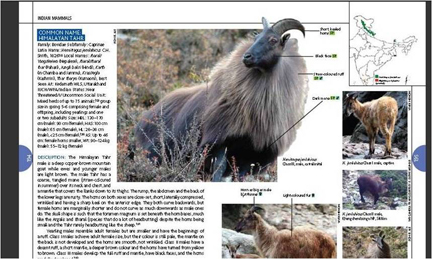Indian Mammals-a field guide by Vivek Menon
-Susan Sharma
What is the best present you can give to yourself or a friend who is going on a trip to a National Park? A field guide on mammals. Field guides on birds are many, but when it comes to mammals other than the tiger, few authentic and user friendly books
are available.The updated field guide by Vivek Menon is a must have for conservationists, travelers to wildlife areas, schools, libraries and institutions.
Covering the rich diversity of mammal species in India, from tigers, elephants, rhinos and whales to primates, rodents and bats, Indian Mammals is a comprehensive, field-ready and illustrated guide. Accompanied by superb full-colour
photographs, supplementary illustrations and distribution maps, and based on impeccable scientific research reviewed by experts, Indian Mammals records details of virtually every mammal known to exist in India. The in-depth, up-to-date text by Vivek Menon,
one of India's leading naturalists and an authority on Indian wildlife, describes key identification features, biometrics, behaviour, social strategies, habitat and distribution.

Passionate wildlife watchers will appreciate the range of coverage and tips on identifying mammals, while naturalists will value the exacting detail needed to distinguish similar species in the field. Planned for easy reference, this compact guide is the
essential resource for wildlifers of any age, from animal watchers and eco-tourists to active conservationists. Field notes reveal uncommon on-site experiences
Andaman Adventure – Barren Island by Deepak Dalal
The best gift for your teen aged daughter or son? Buy her a Deepak Dalal. He introduces the imaginative and curious minds to the natural world outside through an adventure story which will get them hooked.
The hilly terrain surrounding a harbour discovered by Lieutenant Blair is today the bustling city of Port Blair, capital of the Andaman Islands. Teen-aged friends Vikram, Aditya and Chitra – recuperating from their adventure in the Jarawa Jungles – discover
the charm and history of this colourful island city.
Stumbling on a trail of promising clues, Vikram pursues them, tracking men who had abducted him earlier. But powerful criminals thwart his endeavour and unable to escape their wrath, he is forced to undertake a night-voyage destined for alien shores.
In the remote corners of the Andaman Sea lies an island called Barren. On this uninhabited and forgotten outpost of India, Vikram discovers that it is not just a band of desperate men he must pit his wits against. Primal forces of nature – the very ones
that shaped our planet – are at work on Barren, and the smouldering narrative comes to a fiery climax on the island’s lonely shores.
Buy this book at
(Now at a discount of 10% to the displayed price!)